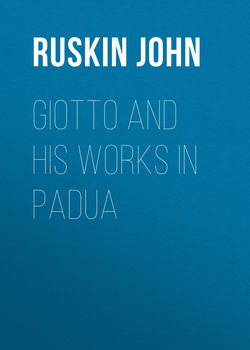Giotto and his works in Padua

Реклама. ООО «ЛитРес», ИНН: 7719571260.
Оглавление
Ruskin John. Giotto and his works in Padua
ADVERTISEMENT
GIOTTO AND HIS WORKS IN PADUA
I. THE REJECTION OF JOACHIM'S OFFERING
II. JOACHIM RETIRES TO THE SHEEPFOLD
III. THE ANGEL APPEARS TO ANNA
IV. THE SACRIFICE OF JOACHIM
V. THE ANGEL (RAPHAEL) APPEARS TO JOACHIM
VI. THE MEETING AT THE GOLDEN GATE
VII. THE BIRTH OF THE VIRGIN
VIII. THE PRESENTATION OF THE VIRGIN
IX. THE RODS ARE BROUGHT TO THE HIGH-PRIEST
X. THE WATCHING OF THE RODS AT THE ALTAR
XI. THE BETROTHAL OF THE VIRGIN
XII. THE VIRGIN MARY RETURNS TO HER HOUSE
XIII. THE ANNUNCIATION.—THE ANGEL GABRIEL
XIV. THE ANNUNCIATION.—THE VIRGIN MARY
XV. THE SALUTATION
XVI. THE NATIVITY
XVII. THE WISE MEN'S OFFERING
XVIII. THE PRESENTATION IN THE TEMPLE
XIX. THE FLIGHT INTO EGYPT
XX. MASSACRE OF THE INNOCENTS
XXI. THE YOUNG CHRIST IN THE TEMPLE
XXII. THE BAPTISM OF CHRIST
XXIII. THE MARRIAGE IN CANA
XXIV. THE RAISING OF LAZARUS
XXV. THE ENTRY INTO JERUSALEM
XXVI. THE EXPULSION FROM THE TEMPLE
XXVII. THE HIRING OF JUDAS
XXVIII. THE LAST SUPPER
XXIX. THE WASHING OF THE FEET
XXX. THE KISS OF JUDAS
XXXI. CHRIST BEFORE CAIAPHAS
XXXII. THE SCOURGING OF CHRIST
XXXIII. CHRIST BEARING HIS CROSS
XXXIV. THE CRUCIFIXION
XXXV. THE ENTOMBMENT
XXXVI. THE RESURRECTION
XXXVII. THE ASCENSION
XXXVIII. THE DESCENT OF THE HOLY SPIRIT
Отрывок из книги
Towards the close of the thirteenth century, Enrico Scrovegno, a noble Paduan, purchased, in his native city, the remains of the Roman Amphitheatre or Arena from the family of the Delesmanini, to whom those remains had been granted by the Emperor Henry III. of Germany in 1090. For the power of making this purchase, Scrovegno was in all probability indebted to his father, Reginald, who, for his avarice, is placed by Dante in the seventh circle of the Inferno, and regarded apparently as the chief of the usurers there, since he is the only one who addresses Dante.1 The son, having possessed himself of the Roman ruin, or of the site which it had occupied, built himself a fortified palace upon the ground, and a chapel dedicated to the Annunciate Virgin.
This chapel, built in or about the year 1303,2 appears to have been intended to replace one which had long existed on the spot; and in which, from the year 1278, an annual festival had been held on Lady-day, in which the Annunciation was represented in the manner of our English mysteries (and under the same title: "una sacra rappresentazione di quel mistero"), with dialogue, and music both vocal and instrumental. Scrovegno's purchase of the ground could not be allowed to interfere with the national custom; but he is reported by some writers to have rebuilt the chapel with greater costliness, in order, as far as possible, to efface the memory of his father's unhappy life. But Federici, in his history of the Cavalieri Godenti, supposes that Scrovegno was a member of that body, and was assisted by them in decorating the new edifice. The order of Cavalieri Godenti was instituted in the beginning of the thirteenth century, to defend the "existence," as Selvatico states it, but more accurately the dignity, of the Virgin, against the various heretics by whom it was beginning to be assailed. Her knights were first called Cavaliers of St. Mary; but soon increased in power and riches to such a degree, that, from their general habits of life, they received the nickname of the "Merry Brothers." Federici gives forcible reasons for his opinion that the Arena Chapel was employed in the ceremonies of their order; and Lord Lindsay observes, that the fulness with which the history of the Virgin is recounted on its walls, adds to the plausibility of his supposition.
.....
In the art of the Goth, the choice of subject was unlimited, and the style of design so remote from all perfection, as not always even to point out clearly the direction in which advance could be made. The strongest minds which appear in that art are therefore generally manifested by redundance of imagination, and sudden refinement of touch, whether of pencil or chisel, together with unexpected starts of effort or flashes of knowledge in accidental directions, gradually forming various national styles.
Of these comparatively independent branches of art, the greatest is, as far as I know, the French sculpture of the thirteenth century. No words can give any idea of the magnificent redundance of its imaginative power, or of the perpetual beauty of even its smallest incidental designs. But this very richness of sculptural invention prevented the French from cultivating their powers of painting, except in illumination (of which art they were the acknowledged masters), and in glass-painting. Their exquisite gift of fretting their stone-work with inexhaustible wealth of sculpture, prevented their feeling the need of figure-design on coloured surfaces.
.....